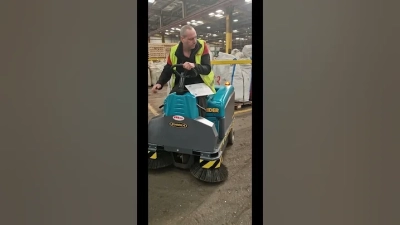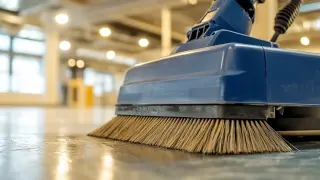Leave Your Message
The Hand Push Sweeper has become an essential environmental cleaning equipment for the commercial and residential sectors in a changing paradigm. Moreover, the global market for cleaning equipment is projected to grow at a very high growth rate, with sales reaching about $50 billion by the year 2025, as available industry reports indicate. This evolution in cleaning equipment is fueled by increasing urbanization and awareness of hygiene and cleanliness, calling for a greater emphasis on efficiency in cleaning solutions. Hand Push Sweepers act efficiently and are generally found useful; they play very important roles everywhere where powered equipment may not be convenient.
Anhui Shuojie Environmental Equipment Co., Ltd. is indeed at the forefront of Hand Push Sweeper manufacturing industry that is a strong commitment towards creating viable cleaning solutions which answer industry standards while solving the challenges of global procurement. As an enterprise that actively specializes in cleaning equipment from commercial use vacuum cleaners to floor scrubbers, the company has an avid commitment to quality. Even as there is no doubt over the applicability of cleaning solutions, navigating the complexities of the supply chain-and ensuring the consistency of product-is vital. Effects on Hand Push Sweepers will be made even more powerful with innovations in technology and rigorous adherence to high industry standards, thereby making further contributions to a cleaner and greener environment.

There has been a marked change in hand push sweeper industry standards in the last few years as the demand for more varied consumer needs grew with advancing technology. The original standards measured mainly some basic efficiency ratings. With passing time, more standards became involved. Various cleaning capabilities, such as sustainability and energy consumption, an ergonomic design, are characteristic of current hand push sweepers. The more recent reports describe energy-efficient cleaning equipment as a preference of over 50% consumers, representing that the shift to green technology has become an important factor of consideration. Furthermore, the rise of the digital marketplace has also led to new challenges for actual marketing and selling of these products. Because of the more digital-oriented approach, there has developed a need for industries to align standards with e-commerce best practices. Continued sophistication in tracking and certification systems is further needed for ensuring product authenticity and conformity with a fast-changing regulatory environment. Industry stakeholders strive to recognize these challenges while at the same time enhance resilience and sustainability of their supply chain similar to the tide moving across multiple industries, including luxury goods and food services. The hand push sweeper industry's development also shows itself in its procurement practices' global adaptations to accommodate different market specifications. Trends show that partnerships and collaborations among manufacturers and suppliers are critical to foster innovation and share responsibilities along the supply chain. While these organizations focus on the competing factors of cost, quality, and compliance, they are aligning their value chain to be more collaborative and sustainable in line with the prevailing industry dynamics.
The industry for hand push sweepers encounters a multitude of global challenges in the procurement of raw materials that severely impact manufacturing. The foremost among these is the fluctuating pricing of raw materials. Extremely high demand for materials of an acceptable standard often casts manufacturers in the centre of a tug-of-war between considerations of cost and product integrity. Changes in the price of raw materials affect budget allocations along with a certain amount of unpredictability in production timelines, which ultimately makes it difficult for the companies to deliver their products on time.
Another snag worth mentioning concerns international trade laws and tariffs. Utilities involved in the manufacture of hand-held sweepers in different regions must update themselves with regard to such ever-changing compliance standards and tariffs, which further complicate their procurement process. Such complexity can lead to increased operational costs and possible delays in shipping and delivery. For manufacturers of hand-push sweepers, ignorance or misinterpretation of such rules and regulations might pose a legal hurdle, costing financial loss.
Sustainable and environmentally friendly materials have become another important variable in global procurement. Consumers' requests for products in compliance with environmental standards have impelled the manufacturers to search for sustainable options. Nevertheless, it can be difficult to source such materials, which might not always be available or financially viable. Hence, manufacturers need to innovate and invest in research to develop workable solutions that could satisfy customer expectations and regulatory standards to remain successfully in the hand-push-sweeper market.
However, eco-friendly practices in the production of hand push sweepers continue to create momentum for sustainable development in the hand push sweeper industry. In answer to growing global demand for cleaning materials that are friendly to the environment, manufacturers have begun embracing designs employing recyclable materials and energy-efficient technology. A more recent report from Market Research Future states that the global eco-friendly cleaner market is anticipated to record a CAGR of 7.5% in the amount of 2021 to 2028, demonstrating the growing significance of sustainability concerning consumer preference.
One of the more significant barriers toward the adoption of sustainable practices has been the sourcing of materials that meet sustainability standards. Numerous suppliers have faced challenges in ensuring that their parts build a performance product, while at the same time, they must pass stringent eco-labeling criteria. The International Journal of Environmental Science and Technology indicates that only about 30 percent of cleaning equipment companies have to a relevant extent adopted sustainable sourcing in their procurement process, leaving room for such companies to innovate where differentiation in a competitive market would certainly benefit them.
Additionally, the production process must meet new sustainability goals. Utilizing renewable energy in the manufacturing process can drastically cut carbon footprints. According to the Global Footprint Network, companies switching to renewable energy resources can cut operational carbon emissions by up to 40%. By following sustainable development policies, the hand push sweeper sector thus plays its part to save the environment and becomes a forefront actor in a market changing rapidly across the globe.
In 2023, the demand for hand push sweepers has increased considerably as various sectors promote cleanliness and efficiency. Urbanization has created a quest for economical cleaning alternatives among businesses and municipalities for public spaces and commercial areas. Hand push sweepers, admired for being eco-friendly and easy to use, pose an attractive alternative to traditional cleaning methods. This shift is being motivated by operational efficiency, as well as rising consumer awareness regarding sustainability.
The trends show that the industries are moving toward those models that provide improved functionality, better suction, and ergonomic designs. With technologies improving, the sweepers are increasingly efficient, enabling greater coverage in lesser time from an operator standpoint, which is the strongest appeal in areas such as warehouses, parks, and shopping complexes. With rising e-commerce, industries and demand in the logistics and retail sectors will thrive since cleanliness and maintenance have a direct bearing on customer experience and safety standards.
With the shifting trends in international procurement, some challenges remain in maintaining uniform quality and industry standards. Manufacturers also face the complexity of various regulations and certification requirements from one region to another, which can buffer the supply chain path. Whoever manages to counter these challenges stands in good stead to become a serious player in the fast-evolving hand push sweeper market, thus encouraging innovation and rivalry in the industry.
Whether or not they are hand push sweepers, regulatory compliance is critical in the manufacture of these types of machines because they impact safety and efficiency. Everywhere in the world, consumers have become more watchful of the products they use; hence, there is more pressure on manufacturers to meet safety criteria. There are many regulations associated with the manufacture and use of sweepers, which are very beneficial for the protection of users and the environment. Understanding these doesn't only entail compliance, but also transports trust and quality in the market.
Safety standards governing sweepers cover numerous subjects, including but not limited to ergonomics, material safety, and operational efficiency. This means, for example, that manufacturers must comply with protocols for designing the handles to relieve strain on users. The materials companies use are subject to assessments regarding safety against harmful exposures during use since these materials are used for constructing sweepers. Being aware of such policies assists organizations in reducing risks to their products concerning recalls and liability claims.
The global procurement challenge brings with it additional complications. Companies must tackle variations in safety standards across different regions. What one market finds acceptable can, in another, be found deficient with respect to its rigorous criteria. This complexity necessitates that manufacturers invest in understanding both international regulations as well as regional nuances in order to ensure compliance and avoid legal pitfalls. Ultimately, a commitment to regulatory compliance not only enhances product quality but also bolsters a company's reputation in an increasingly competitive industry.
Increasing modernization is causing a shift in the hand push sweeper industry, which consequently improves the efficiency and performance of their equipment. Modern hand push sweepers now boast of newer features such as improved designs for brushwork, advanced filtration, and ergonomic controls. These updates not only increase cleaning efficiency but actually decrease the strain on the operator by making it more readily maneuverable in different environments.
The one further area still being impacted by technology-related improvements is battery efficiency and life. Manufacturing emphasis is now on either electric models that run longer, solutions for fast-charging that minimize downtime, or lightweight materials for easy movement. Thus enabling site and maintenance teams to finish cleaning operations in less time and with less noise for addresses the environmental and operational needs of modern workplaces.
Furthermore, this technology-drivenness is proving to be instrumental in performance and maintenance monitoring. Smart sensors fitted in hand-pushed sweepers can enable realtime insights about equipment status, thereby alerting users while the problem is still minor. Such preventive capabilities create better outcomes in productivity and protect procurement decisions to be worthy, complying with global standards and sustainability goals. With the ever-growing trend in this form of technology, the ability to combat these procurement handicaps and maximize efficiencies will be the core determinant for thorough development.
Budgeting strategies for procurement are essential with the changing dynamics in the business landscape of the hand push sweeper industry. Recent reports indicate the global market, hand push sweeper sales are expected to grow at a compound annual growth rate (CAGR) of about 5% by 2024. This, in turn, creates a driving force within organizations, thus necessitating an entrenched cost analysis mechanism to improve procurement processes.
It is important to budget adhering to the regional variations in costs of sourcing the hand push sweepers. That's because different areas will have different prices of materials, labor, and logistics depending on the economic condition in the area. For instance, in China which pursues the world-class procurement management system, the reform is aimed at reducing costs and enhancing quality in the products manufactured. A report of the International Purchasing and Supply Management Alliance emphasizes that effective digitization of procurement processes can reduce costs as much as 20% to companies.
Participation in international trade events such as the upcoming Guangzhou Fair enables the business to do business with foreign suppliers and improve their procurement strategy. The event receives growing interest from foreign buyers, thus emphasizing the importance of establishing and maintaining strong relationships with suppliers. The focus of companies will, therefore, be in the immediate term for what the costs will look like, and next, supply chains which are resilient for future disruptions.
Supplier diversity is another hallmark in sourcing for the global hand-push sweeper procurement segment, which has undergone many changes. A focus on diversification may inspire creative solutions and a competitive edge, as a quality supplier cannot allow deviations in quality or manufacturing standards. Accordingly, engaging a variety of suppliers allows companies to mitigate the risks of relying solely on a particular supplier while also benefiting from different innovative techniques of production and unique product offerings that can meet various consumer needs.
In addition, the recent trends in vacuum technology serve as a parallel once again for the hand-push sweeper market. As car vacuums and handheld devices are continuously adapted to cater to specific demands like those for pet hair or cleaning tricky staircases, hand-push sweepers are also being fine-tuned to descend into different environments and onto different surfaces. Companies involved in the global trade of this product should put evermore emphasis on suppliers that appreciate these limitations and deliver bespoke solutions that respond well to the modern cleaning conundrums. A broader adoption of these diversities will spur innovation and arm the businesses with the ability to address complexities of global procurement in a rapidly changing market.
The hand push sweeper industry hassling tough challenges in adhering to the quality control metrics needful in order to sustain its competitive advantage in global procurement. The report released by Market Research Future estimates that hand push sweepers will touch $1.5 billion globally by 2025 at a CAGR of 5% since 2020. With the increasing demand, manufacturers will now have to give more importance to quality at the time of production in order to fulfill the prevailing customer expectations and regulatory requirements.
Quality control in the production of hand push sweepers encompasses some important standards, including material durability, operational efficiency, and user safety. Research conducted by the International Organization for Standardization (ISO) asserts that products conforming to ISO 9001 standards have about 25% fewer defects, which greatly enhances brand reputation and customer satisfaction. Such stringent quality control methods will ensure compliance with international standard norms while reducing production costs and wastage due to preventable defects.
Also, technological advancements are changing the face of quality assurance in respect to manufacturing hand push sweepers. Production quality monitoring in real-time, using statistical analysis tools together with automated inspection systems, has been firmly established. The American Society for Quality reports that companies applying these technologies can enhance overall product quality up to 30%, thus advancing stronger procurement pathways. Focusing on quality control metrics will be one of the fundamental parameters for manufacturers looking to succeed in the competitive global marketplace.
The hand push sweeper industry has now entered a phase of transformation with new technologies and changing consumptions habits. Urban areas are focusing on sustainability and cleanliness, and the manufacturers are finding ways to include improved features for the performance and efficiency of the sweeper. Innovations like smart sensors and automated navigation systems bring a sea change to traditional models that were once very hard to use and very inefficient: Now they can track where debris lies, making them more efficient cleaning routes and reduced operational costs.
Next, the emergence of eco-friendly raw materials and energy-efficient designs makes a huge difference for the industry. Manufacturers are focusing on producing goods with the highest cleaning abilities and minimal environmental impact. Electric-powered hand push sweepers, being quieter and more sustainable than gas-powered models, are taking off. Not only does this instill a positive image toward eco-friendly consumers, but it also supports the worldwide movement to minimize carbon footprints.
The future of the hand-pushed sweeper industry will imply that companies partner together to resolve the continued challenges. Companies are to be aware of market trends as well as what the regulatory environment expects, while innovation will create solutions to these demands. This industry is focused, in the future, on balancing the two, functionality, and sustainability, while ensuring that these cleaning tools, which are essential to basic human living, adapt to the rapidly changing nature of urban existence.
Today's standards for hand push sweepers are influenced by cleaning capabilities, sustainability, energy consumption, and ergonomic design, in addition to traditional efficiency metrics.
Over 50% of consumers now prefer cleaning equipment that is certified for energy efficiency, indicating a shift towards greener technology as a crucial purchasing criterion.
Manufacturers face challenges such as volatility in raw material prices, navigating international trade regulations and tariffs, and the need to source sustainable materials.
Quality control is essential for meeting customer expectations, regulatory requirements, and minimizing production costs and waste while ensuring product durability and user safety.
Fluctuations can affect budget allocations and create unpredictabilities in production timelines, complicating the ability to deliver products on schedule.
Partnerships and collaborations between manufacturers and suppliers are critical for fostering innovation and optimizing responsibility distribution along the supply chain.
Innovations such as advanced analytics tools and automated inspection systems allow manufacturers to monitor production quality in real-time, improving overall product quality by as much as 30%.
The global market for hand push sweepers is expected to reach $1.5 billion by 2025, growing at a CAGR of 5% from 2020.
Adhering to ISO 9001 standards can result in 25% fewer defects, enhancing brand reputation and customer satisfaction, and ensuring compliance with international standards.
Sourcing sustainable materials can be difficult due to availability and cost-effectiveness, requiring manufacturers to innovate and invest in research to meet consumer expectations and regulatory requirements.





